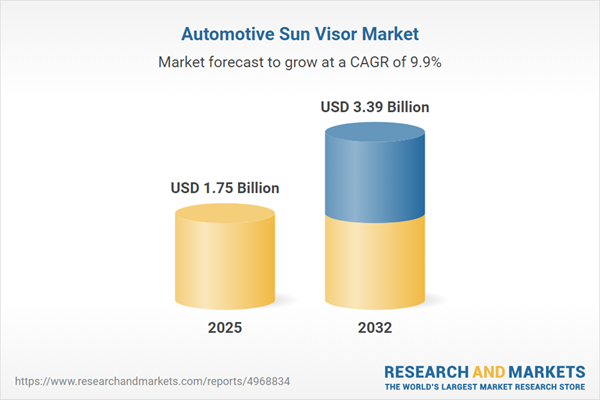Speak directly to the analyst to clarify any post sales queries you may have.
To remain agile in the competitive automotive sun visor market, senior leaders need concise, actionable intelligence that informs strategic planning as the industry experiences fast-paced evolution in both compliance and consumer demand.
Market Snapshot: Automotive Sun Visor Market Overview
The automotive sun visor market is exhibiting strong, sustained growth supported by design innovation and wider supplier networks. Currently valued at USD 1.59 billion, the market is forecast to reach approximately USD 3.39 billion by 2032, advancing at a compound annual growth rate (CAGR) of 9.87%. This trajectory is underpinned by sector-wide efforts to enhance sustainability, meet higher regulatory benchmarks, and accelerate development of adaptive, technology-driven solutions. Leading manufacturers are elevating standards by deploying next-generation materials and processes, fostering increased competition and rapid response to shifting customer needs. Both established companies and new entrants are adjusting quickly to changing end-user expectations and stricter compliance requirements.
Scope & Segmentation: Navigating Automotive Sun Visor Market Complexity
- Material Types: Advanced polymers, such as Acrylonitrile Butadiene Styrene (ABS), polycarbonate ABS, and polypropylene, are employed by manufacturers. This allows for the delivery of lighter, safer, and increasingly sustainable sun visor solutions that resonate with regulatory and environmental priorities.
- Technology Types: Modern automotive sun visors—whether fixed or adjustable—are enhanced through digital manufacturing. These developments promote better ergonomics, adaptability, and strict alignment with OEM safety and quality demands.
- Visor Types: The market offers portfolios covering standard single, dual, and smart visors fitted with integrated LCD displays, serving both conventional vehicle owners and those needing greater connectivity and advanced features.
- Application Segments: Product innovation is directed toward commercial fleets, passenger vehicles, hatchbacks, vans, and SUVs. Such breadth enables tailored solutions for distinct regional compliance requirements and user preferences.
- Distribution Channels: OEM partnerships are central to supply strategies, while aftermarket options gain significance as vehicle demand grows and aftersales service models evolve.
- Geographic Regions: Market dynamics shift across the Americas, Europe, the Middle East, Africa, and Asia-Pacific, with local certification, technology adoption, and regional trends influencing supplier decisions and business growth.
- Key Manufacturers: Companies including CARiD, Continental AG, Grupo Antolin, Toyota Boshoku Corporation, Gentex Corporation, and Knauf Industries drive the sector. These players emphasize compliance, robust production, and adaptable distribution strategies.
Key Takeaways for Senior Decision-Makers
- Advanced composites and polymers enable unique sun visor designs, giving suppliers an edge in contract negotiations and supporting sustainability targets.
- Emerging smart visor technologies, such as integrated displays and glare reduction features, address growing market interest in enhanced comfort and digital integration.
- Flexible, agile manufacturing and diversification across suppliers strengthen supply chain resilience and support rapid responses to regulatory or market disruptions.
- Collaborative initiatives with OEMs streamline the adoption of new technologies and facilitate alignment with quality and performance standards.
- Incorporating regional certification processes and end-user input supports localized strategies, improving new product launch success across varying markets.
- Adopting digital prototyping and upgraded workflow systems speeds up and improves the accuracy of product introductions in multiple vehicle segments.
Tariff Impact: United States Trade Developments
Changes in United States trade and tariff policy drive automotive organizations to revisit sourcing and production decisions. By localizing operations and optimizing supply chains within North America, companies bolster long-term continuity and build resilience against potential global disruptions.
Methodology & Data Sources
This report is based on comprehensive executive interviews, analysis of global trade data, and review of patent activity. By synthesizing detailed regulatory filings and proprietary corporate reports, the research delivers well-substantiated, balanced findings supported by both qualitative and quantitative evidence.
Why This Report Matters: Strategic Insights for Senior Leaders
- Thorough analysis of market segments and technologies empowers suppliers to innovate in sustainable materials and digital features, enhancing overall competitive positioning.
- Action-oriented recommendations equip executives to quickly allocate resources and address fast-paced regulatory and technological shifts.
- Integrated strategies support leadership in staying ahead of evolving compliance and consumer trends, enabling timely product launches and ongoing adherence to global standards.
Conclusion
Accessing structured market intelligence gives senior leaders the capability to proactively adjust strategies in line with supply chain and regulatory shifts, ensuring continued agility and long-term growth in the automotive sun visor sector.
Additional Product Information:
- Purchase of this report includes 1 year online access with quarterly updates.
- This report can be updated on request. Please contact our Customer Experience team using the Ask a Question widget on our website.
Table of Contents
3. Executive Summary
4. Market Overview
7. Cumulative Impact of Artificial Intelligence 2025
Companies Mentioned
The companies profiled in this Automotive Sun Visor market report include:- CARiD
- Continental AG
- Dongfeng Motor Parts and Components Group Co., Ltd.
- GRIOS s.r.o.
- Grupo Antolin
- Hammacher Schlemmer & Company, Inc.
- Hayashi Telempu Co., Ltd.
- Kasai Kogyo Co., Ltd.
- KB Foam Inc.
- Martur Fompak International
- Nye Lubricants, Inc.
- Patent Yogi LLC
- Reed Relays and Electronics India Limited
- Toyota Boshoku Corporation
- Dorman Products, Inc.
- Ripper Merchandise, LLC
- Nifco Inc.
- Shigeru Co., Ltd.
- Gentex Corporation
- Atlas Holdings LLC
- Knauf Industries
- AGC AUTOMOTIVE EUROPE SA
- American Stitchco, Inc.
- Leman Industries
Table Information
| Report Attribute | Details |
|---|---|
| No. of Pages | 195 |
| Published | November 2025 |
| Forecast Period | 2025 - 2032 |
| Estimated Market Value ( USD | $ 1.75 Billion |
| Forecasted Market Value ( USD | $ 3.39 Billion |
| Compound Annual Growth Rate | 9.8% |
| Regions Covered | Global |
| No. of Companies Mentioned | 25 |









